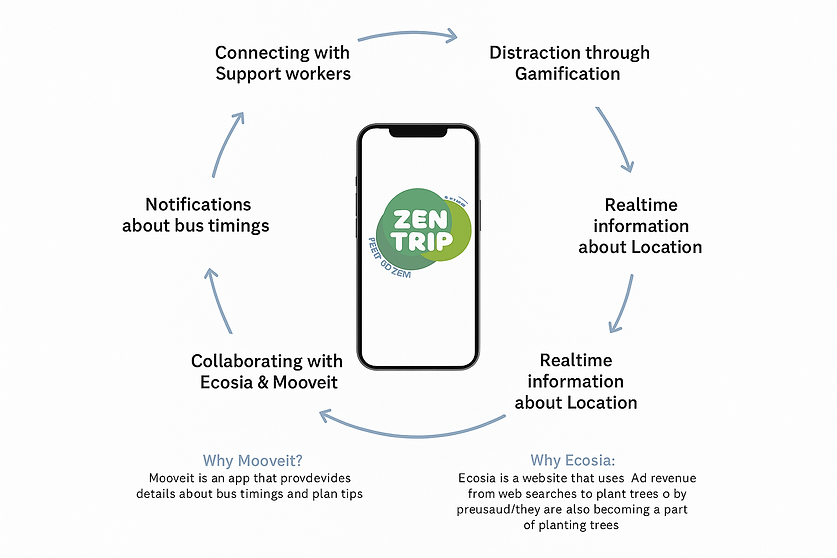ZenTrip
A service design concept that improve accessibility for neurodiverse community in public transport


The Problem
Public transport systems can be overwhelming for neurodiverse individuals due to sensory overload, unpredictable changes, and complex navigation.
Traditional transit apps often lack features that support diverse cognitive needs, leading to stress, disorientation, and reduced independence.
The Solution
ZenTrip is a service design concept designed in collaboration witn Mischelin Scotland Innovation parc Ltd. Zentrip helps neurodiverse individuals to feel more relaxed when using public transport, specifically busses, opening up sustainable mobility to a group of inviduals who currently struggle with transport.
It helps planning journey much easier, gamifying the travel experience, while providing assistence by support workers for when users really need it.
Methodology
1. Research

In the begining, the project aimed at understanding sustainable mobility in a wide group of people. this includes analysing existing products and services related to sustainable mobility.
Interviews
About 15 people were interviewed focusing on a common theme which is people and their experience with public transport. For better understanding and identifying pain points, the insights were processed to empathy map and storyboards.


User need statement
As a person with mental health difficulties
I want to avoid Public transport
Beacuse its too noisy, filled with people i dont know
But it is my only option to get to places. So its a necessity
Identifying Theme
5 WHY'S and 4 W'S were used for identifying the theme and to develop the ideas and identify the key focus points. At this stage, 'sustainable mobility' and 'neurodiversity' are combined which was the topic that aroused on primary interviews.
The root cause found to be the system we have works to an extent but it needs upgrade to be more inclusive


HMW Statement
"HMW we replace negative emotions when using public transport with positive emotions through the use of distraction and calming exercises/games"
"HMW open sustainable travel to a wider comminity of people who might have felt previously excluded due to hidden disabilities"
Survey
A survey was conducted among neurodiverse people to understand what,when and barriers that prevent from using public transport





2. Workshop

For further understanding user needs, an explorative workshop was conducted. However despite carefully planning a workshop which was to be interactive, few responses were received from participants as they aren't comfortable in participating.
So it was necessary to adapt to the situation, especially while working with people with disabilities.

3. Data Synthesis

Affinity Clustering
The data colleceted from quantitative research and qualitative research was processed to affinity clusters. It helped to get clear understanding of what is going well, what need to be better and comparing it with existing solutions.
It was found anxiety was one of the major problems that make them hesitate to use public transport

Empathy Map
for clear understanding of their pain and gain, an empathy map was develop from available data. This helped to be in track.

4. Idea Generation

RIP+MIX
RIP+MIX is an effective idea generation tool that helps combining function, physical form, emotional characteristics and matertial.
Here, two random items, seat and keys were selected to think of how to utilize distraction for sustainable travel.
The new product was a chair with fidget built-in, making the journey playful,distracted from anxiety and to feel less daunting.

Creative Matrix
Creative Matrix was the second idea generation framework. This is an effective tool to think creative and generate number of ideas that can be technology/ games/facilities and environment.
The created ideas are then arranged using Important-Difficulty Matrix. The final idea is selected depending on how imprtant it is or how difficult it is for the business to execute.

Important-Difficulty Matrix

WHAT?
'WHAT', which was left empty in 5 W'S on early research was filled now as the common idea, which was easy to achieve was designing an 'App'.

AN APP!

5. Cognitive Walkthrough

Cognitive walkthrough is a usability inspection method that simulates a new user's experience to evaluate the learnability of a system or interface.
It helps for systematically analyzing the service journey, focusing on how easily a new user would be able to complete the task

Hypothesis Statement
We Believe...
creating soothing anti-anxiety, distraction game that provdes a relaxing environment for passengers
To find this to be true..., we will create the app wireframe and present it to a facebook group for the neurodiverse community for stakeholder review.
Will result in... encouraging neuro-diverse people to choose public trasport which are already in place for sustainable mobility
And measure people’s reactions to identify ways to improve systems that may trigger anxiety—by asking how easy it is to use, how useful they seem, suggestions for improvement.
Beacuse... they will have something productive and creative to channel their negative emotions into positive and not feel as stressed on the bus with extra support
How does it work?

6. Service Blueprinting


Business Model Canvas

User Need Statement

7. UI Design

8. User Testing
The Figma Prototype was tested among 14 inviduals. The results founnd that the majority of users find it distracting, calming and more accessible compared to existing solutions.

Possible Barriers
-
Relies on people engaging in the app and volunteers to get it off the ground.
-
Not a one size fits all solution. people with different neurodiversities may respond better than others
-
It only address a small number issues from our research that could arise with public transport. for example: no seats, too busy, too loud, bus breaking down etc, as these are out of our control